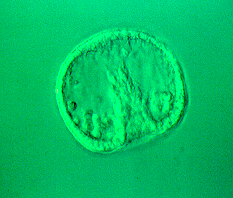Biomechanics of morphogenesis

In order for morphological changes to occur in developing embryos, mechanical forces must be exerted. Therefore, if we are to unravel the mechanisms responsible for morphogenesis, it is crucial that we complement molecular studies of the control of morphogenesis with analyses of the physics of how morphogenetic processes occur. We studied the biomechanics of various morphogenetic processes in early sea urchin and frog embryos. Our work involved measurement of mechanical properties of and force production by embryonic tissues, as well as manipulative experiments to test various hypotheses about the physical mechanisms causing specific morphogenetic events. We also used physical models to determine how the fiber-reinforcement of notochords and of bacterial walls affect their shapes. We are currently studying how differential growth patterns of kelp blades affects the shapes they assume in different flow habitats.
Selected references on this topic
- Koehl, M. A. R. (1990) Biomechanical approaches to morphogenesis. Seminars in Developmental Biology 1: 367-378. (overview)
- Koehl, M. A. R., D. S. Adams, and R. E. Keller (1990) Mechancial development of the notochord in early tail-bud amphibian embryos. pp. 471-485. In, N. Akkas [ed.], Biomechanics of Active Movement and Deformation of Cells. Springer-Verlag.
- Adams, D. S., R. E. Keller, and M. A. R. Koehl (1990) Mechanism of straightening and elongation of the notochord of Xenopus laevis. Development. 110: 115-130.
- Lane, M. C., M. A. R. Koehl, F. Wilt, and R. Keller (1993) The role of regulated secretion of apical extracellular matrix in epithelial invagination. Development 117: 1049-1060.
- Davidson, L. A., M. A. R. Koehl, R. Keller, and G. F. Oster (1995) How do sea urchins gastrulate? Distinguishing between mechanisms of primary invagination using biomechanics. Development 121: 2005-2018.
- Moore, S. W., R. E. Keller, and M. A. R. Koehl. (1995) The dorsal marginal zone stiffens anisotropically during its convergent extension in the gastrula of Xenopus laevis. Development. 121: 3131-3140.
- Elul, T., M. A. R. Koehl, and R. Keller. (1997) Cellular mechanisms underlying neural convergent extension in Xenopus laevis embryos: Neural deep cell explants. Devel. Biol. 191: 243-258.
- Davidson, L.A., G.F. Oster, R.E. Keller, and M.A.R. Koehl. (1999) Measurements of mechanical properties of the blastula wall reveal which hypothesized mechanisms of primary invagination are physically plausible in the sea urchin Strongylocentrotus purpuratus. Devel. Biol. 209: 221-238.
- Koehl, M.A.R., K.J. Quillin, and C. Pell. (2000) Mechanical design of fiber-wound hydraulic skeletons: The stiffening and straightening of embryonic notochords. Am. Zool. 40: 28-41.
- Koehl, M. A. R. (2003) Physical modelling in biomechanics. Phil Trans. Roy. Soc. Lond. B 358: 1589-1596.
- Wolgemuth, C. W., Y. Inclan, J. Quan, G. Oster and M. A. R. Koehl (2005) How to make a spiral bacterium. Physical Biology 2: 189-199.
- Koehl, M. A. R. , W. K. Silk, H. Liang, and L. Mahadevan. (2008) How kelp produce blade shapes suited to different flow regimes: A new wrinkle. Integr. Comp. Biol. 48: 318-330.
Links to Specific Topics
- Fluid dynamics of hairy little legs
- Microscopic organisms swimming in turbulent flow/Larval Settlement
- Fluid dynamics of odor capture by olfactory antennae
- Selective factors in the evolution of multi-cellularity
- How do benthic organisms withstand and utilize moving water?
- Biomechanics of hydrostatic skeletons
- Evolution of novel function / Consequences of body size
- Fluid dynamics of animals at intermediate Re
